|
INDEPENDENCE National Historical Park |
 |
Two Centuries of Independence Hall
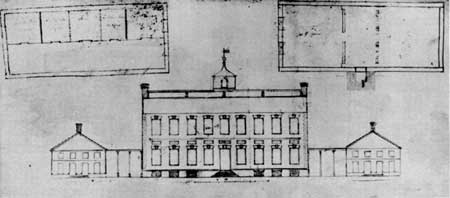
Plan of the State House, 1732, attributed to
Andrew Hamilton. The elevation of the main building shows it
substantially as first built. A skimpy plan like this seems inadequate
to people of the 20th century, accustomed to meticulous architectural
drawings. Detailed drafts had not been introduced in the 1700's; rather,
the master builders in the field were a combination of what we would
call today architects, engineers, and workmen. On them lay the burden of
supplying the technical details between the simple sketch and the
finished structure. Such a man was Edmund Woolley, master carpenter of
the State House.
Courtesy Historical Society of
Pennsylvania.
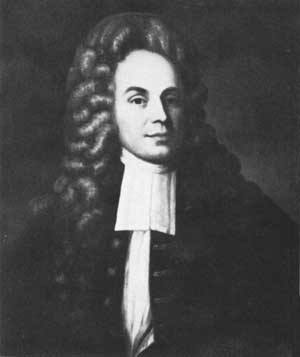
Andrew Hamilton, an eminent lawyer and Speaker of
the Assembly, superintended the building of the State House.
From a portrait copied by Adolf Wertmuller (1751—1811) from an
original now lost. Courtesy Historical Society of
Pennsylvania.
In February 1752, in order to accommodate its committees, the Assembly ordered the erection of a suitable room adjoining the southeast corner of the building. Work was begun immediately, and the room was completed some time during the following year. Demolished probably around 1812, the chamber was described by a contemporary as "a very elegant apartment." This room also served as the library of the Assembly and was well equipped with sets of English statutes along with works on history and literature.
With the completion of the committee room and library, no additional structures were erected in the State House Yard during the Colonial period. However, other buildings were contemplated. On February 20, 1736, the Assembly reserved the lots on Chestnut Street at the corners of Fifth and Sixth Streets for the erection of a city hall and county courthouse within the next 20 years, but these buildings were not constructed until several years after the Revolution.
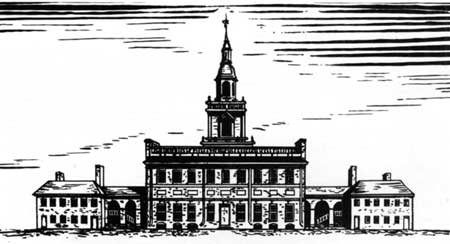
The State House as it appeared in the Colonial
period, showing the wings, connecting "piazzas" with stairways, and
original steeple. As first designed (see preceding illustration) and
built, the State House had no tower or steeple. These were added around
mid-century, and a bell was ordered for the steeple in 1751. This State
House bell, which was hung in the new addition in 17553, has since
become renowned as the Liberty Bell. This drawing and the next six are
modern illustrations based on 18th-century written descriptions and
pictures.
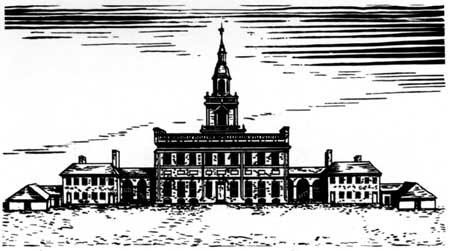
The State House, about 1776, with wing buildings
adjoined by wooden sheds. These were used during the Revolutionary War
to store ammunition and, perhaps, to shelter Indian delegations at
various times. The wings were used as office space and, in part, even as
living quarters for the doorkeeper and his family.
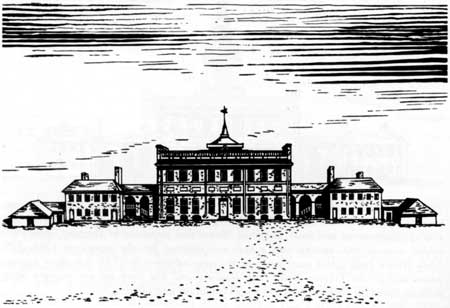
By 1773, the steeple had rotted to a dangerous
extent. It had become so weak that ringing of the hell was avoided for
fear of toppling the steeple. Though the Pennsylvania Assembly had long
intended to remove this hadly decayed structure, it was not done till
1781—the year of the British surrender at Yorktown, Va. After the
steeple was removed, the brick tower was covered with a hipped roof,
shown here, and the hell hung just below it.
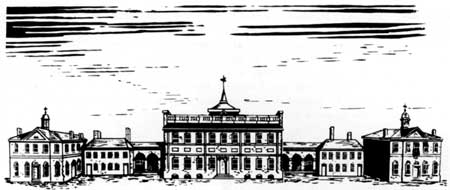
The wooden sheds were removed some time after 1787
to make way for the City Hall on the east (left) and County Courthouse
on the west (right). Begun in 1790 and 1787 and completed in 1791 and
1789, respectively, these buildings fulfilled the original plan of a
city governmental center as conceived by Andrew Hamilton. With the
establishment of the temporary Federal capital in Philadelphia, from
1790 to 1800, City Hall became the seat of the U. S. Supreme Court and
the County Courthouse became Congress Hall.
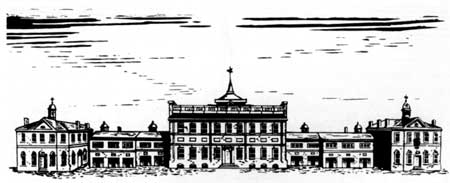
In 1812, the Pennsylvania Legislature permitted
the City and County of Philadelphia, which occupied the State House
after the Federal and State capitals moved from Philadelphia, to pull
down the east and west wings and erect in their places "modern" office
buildings, designed by the architect Robert Mills. These buildings were
used for the purposes of municipal administration and storing records.
Because of the burden on public funds, the State House was dangerously
close to being torn down at this time. It was spared that fate when the
City bought the group of buildings and the square from the Commonwealth
of Pennsylvania in 1818 for $70,000.
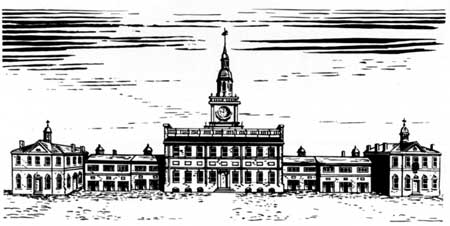
Lafayette's visit, in 1824, started a move to lift
the State House from neglect and direct attention to it as a shrine. In
line with this new attitude, attempts were made to restore the building
to its original appearance. The first important step in this direction
was the restoration of a steeple to the building. William Strickland,
the famous American architect, designed a new one which was constructed
in 1828; it was not an exact replica, but followed the general design of
its predecessor removed in 1781. The principal deviations were the
installation of a clock in the steeple and the use of more
ornamentation.
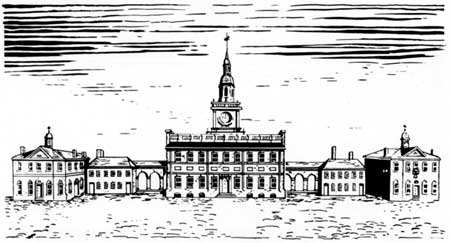
Although various alterations were made to the
interior of the State House—by now, generally called Independence
Hall—in the mid-nineteenth century, appreciable exterior changes
were not made till just before 1900. Between 1896 and 1898, as part of
the City's general program for the restoration of Independence Square to
its appearance during the Revolution, the Mills buildings were replaced
by wings and arcades which resembled those of the 18th century. The
buildings have retained this appearance to the present
day.

|

| History | Links to the Past | National Park Service | Search | Contact |
|
Last Modified: Mon, Dec 2 2002 10:00:00 am PDT |

